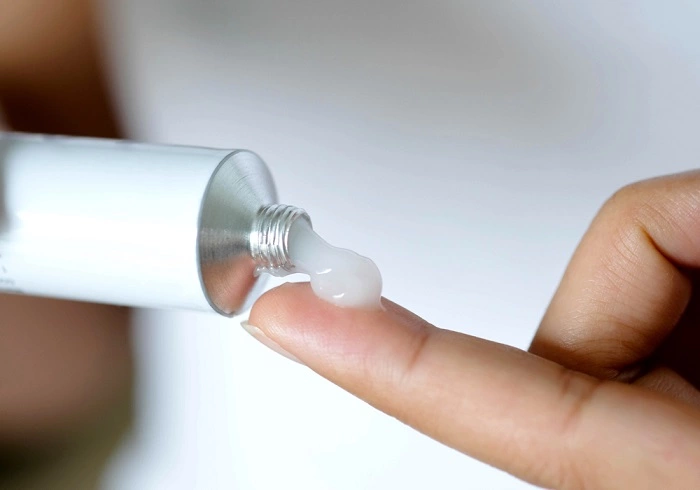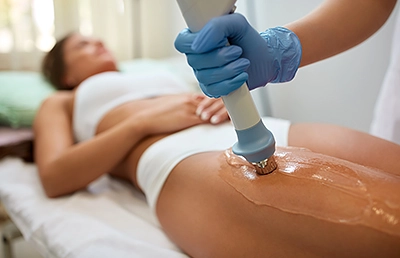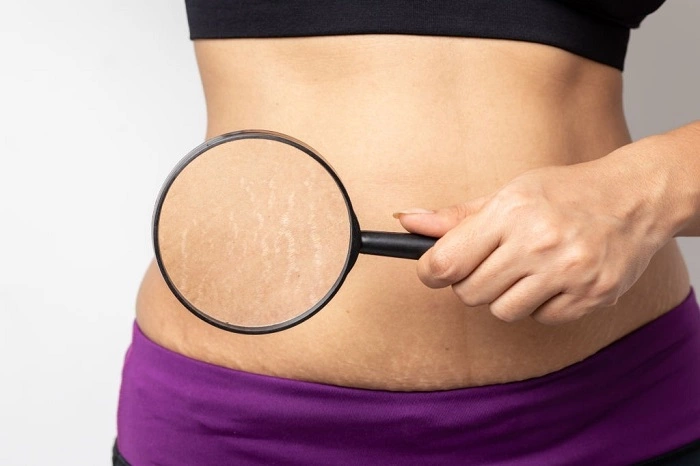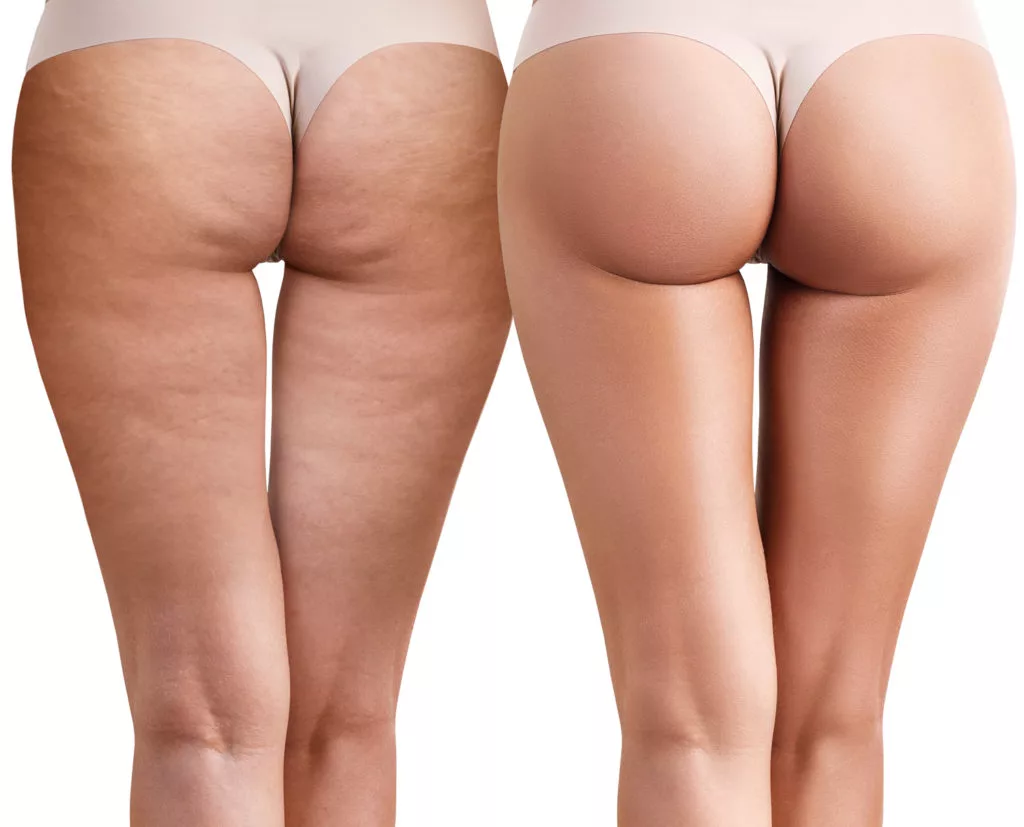In this article, we will introduce you to cellulite treatments methods and tell you if cellulite treatments is really effective.
Table of Contents
what is Cellulite
Cellulite is a common cosmetic condition that affects the skin, particularly in areas such as the thighs, buttocks, and hips. It is characterized by the appearance of dimpled, lumpy skin caused by the underlying fat deposits pushing against the connective tissue beneath the skin.
Cellulite occurs when the fat cells within the subcutaneous layer of the skin (the layer just beneath the surface) become enlarged, which causes them to press against the connective tissue. The connective tissue, which is arranged in a network of vertical and horizontal strands, can become stretched and weakened over time, allowing the fat cells to bulge through, resulting in the characteristic dimpled appearance of cellulite.
Cellulite is more common in women than men, and it can be influenced by a variety of factors, including genetics, hormonal changes, poor diet, lack of exercise, and aging. While cellulite is not harmful, many people feel self-conscious about its appearance and seek treatments to improve the look of their skin.

Cellulite treatments
Cellulite treatments are methods used to improve the appearance of cellulite, which is the dimpled, lumpy skin that often appears on the thighs, buttocks, and hips. There are a variety of treatments available, but their effectiveness can vary depending on the individual and the severity of their cellulite.
Some common cellulite treatments include:
- Topical creams and lotions: There are many products on the market that claim to reduce the appearance of cellulite. These creams and lotions often contain ingredients like caffeine, retinol, and antioxidants that are thought to improve circulation and reduce inflammation in the skin.
- Massage therapy: Massage can help improve circulation and break up the fatty deposits that contribute to cellulite. Some spas offer specialized cellulite treatments that use techniques like lymphatic drainage and deep tissue massage to improve the look of the skin.
- Laser and light therapy: These treatments use lasers or light energy to break up the fat deposits that cause cellulite. They can also stimulate collagen production, which can help improve the texture and elasticity of the skin.
- Radiofrequency: Radiofrequency treatments use heat to tighten the skin and stimulate collagen production. This can help improve the appearance of cellulite by smoothing out the skin and reducing the appearance of dimples.
- Cellulite reduction surgery: In severe cases, some people opt for surgical procedures like liposuction or cellulite reduction surgery to remove excess fat and tighten the skin.
It’s important to note that while these treatments may be effective for some people, they are not a guarantee and may not work for everyone. Additionally, maintaining a healthy diet, staying hydrated, and exercising regularly can also help reduce the appearance of cellulite.

Topical creams and lotions for the Cellulite treatments
Topical creams and lotions are a popular non-invasive treatment option for cellulite ( Cellulite treatments ). They work by improving the appearance of the skin by reducing the appearance of dimpling and improving the texture and tone of the skin. Here are some common ingredients found in topical cellulite creams and lotions:
- Caffeine: Caffeine is a stimulant that can help improve circulation and reduce inflammation in the skin. It is thought to work by breaking down fat cells and reducing the appearance of cellulite.
- Retinol: Retinol is a form of vitamin A that is often used in skin care products. It can help improve the texture and tone of the skin, and is thought to work by stimulating collagen production and reducing inflammation in the skin.
- Antioxidants: Antioxidants like vitamin C and E can help protect the skin from damage caused by free radicals. They are also thought to help improve the appearance of cellulite by reducing inflammation and stimulating collagen production.
- Plant extracts: Some cellulite creams and lotions contain plant extracts like green tea, ginkgo biloba, and horse chestnut. These ingredients are thought to improve circulation and reduce inflammation in the skin.
It’s important to note that while topical creams and lotions can be effective for some people, their efficacy can vary depending on the individual and the severity of their cellulite. Additionally, maintaining a healthy lifestyle with a balanced diet and regular exercise can also help reduce the appearance of cellulite.

Massage therapy for Cellulite treatments
Massage therapy is a non-invasive treatment option for cellulite ( Cellulite treatments ) that involves using various massage techniques to improve circulation, break up fatty deposits, and smooth out the skin. There are several types of massage therapy that are commonly used for cellulite treatments, including:
- Lymphatic drainage massage: This type of massage focuses on improving lymphatic flow, which can help remove toxins and excess fluids from the body. It involves gentle, rhythmic movements that stimulate the lymphatic system and promote detoxification.
- Deep tissue massage: Deep tissue massage involves applying pressure to the deeper layers of muscle tissue to break up adhesions and release tension. This can help improve circulation and reduce the appearance of cellulite.
- Swedish massage: Swedish massage is a gentle, relaxing massage technique that involves long, flowing strokes. It can help improve circulation and reduce stress, which may contribute to the development of cellulite.
- Myofascial release: This technique involves applying sustained pressure to the connective tissue that surrounds the muscles. It can help improve circulation and break up adhesions, which can reduce the appearance of cellulite.
While massage therapy can be effective for some people, its efficacy can vary depending on the individual and the severity of their cellulite (Cellulite treatments). Additionally, maintaining a healthy lifestyle with a balanced diet and regular exercise can also help reduce the appearance of cellulite.

Laser and light therapy
Laser and light therapy are non-invasive treatment options for cellulite (Cellulite treatments) that work by heating the skin and underlying tissue to stimulate collagen production and break down fat cells. There are several types of laser and light therapy that are commonly used for cellulite treatments, including:
- Radiofrequency (RF) therapy: This type of therapy uses radio waves to heat the skin and underlying tissue, which can help stimulate collagen production and break down fat cells. It can also improve circulation and lymphatic drainage.
- Low-level laser therapy (LLLT): LLLT uses low-level lasers to target fat cells and stimulate collagen production. It is thought to work by increasing the permeability of the fat cell membranes, allowing the fat to be released and eliminated from the body.
- Intense pulsed light (IPL) therapy: IPL therapy uses high-intensity pulses of light to heat the skin and break down fat cells. It can also improve the texture and tone of the skin.
Laser and light therapy can be effective for some people, but their efficacy can vary depending on the individual and the severity of their cellulite. Additionally, these treatments can be expensive and may require multiple sessions to achieve the desired results. Maintaining a healthy lifestyle with a balanced diet and regular exercise can also help reduce the appearance of cellulite (Cellulite treatments).
Radiofrequency for Cellulite treatments
Radiofrequency (RF) therapy is a non-invasive treatment option for cellulite (Cellulite treatments) that uses radio waves to heat the skin and underlying tissue. This heating effect can stimulate collagen production, improve circulation and lymphatic drainage, and break down fat cells, which can reduce the appearance of cellulite.
During an RF treatment, a handheld device is used to deliver radio waves to the skin. The device is moved over the treatment area in a circular motion, and the heat generated by the radio waves is absorbed by the skin and underlying tissues. The heat causes the collagen fibers in the skin to contract, which can help tighten and firm the skin. It can also stimulate new collagen production, which can improve the texture and tone of the skin.
RF therapy can be an effective treatment option for cellulite, but its efficacy can vary depending on the individual and the severity of their cellulite. Multiple treatments may be necessary to achieve the desired results, and maintenance treatments may be required to maintain the results. As with any cosmetic treatment, it’s important to consult with a qualified healthcare professional to determine if RF therapy is right for you. Additionally, maintaining a healthy lifestyle with a balanced diet and regular exercise can also help reduce the appearance of cellulite.
Cellulite reduction surgery
Cellulite reduction surgery (Cellulite treatments) is a cosmetic procedure that involves the removal of fat deposits and the repositioning of the skin to improve the appearance of cellulite (Cellulite treatments). There are several types of cellulite reduction surgeries, including:
- Liposuction: Liposuction is a surgical procedure that involves the removal of fat from the body using a suction device. It can be used to remove fat deposits from areas affected by cellulite, but it is not specifically designed to treat cellulite.
- Cellulaze: Cellulaze is a minimally invasive procedure that involves the use of a laser to break up fat cells and stimulate collagen production. It can help improve the appearance of cellulite by reducing the thickness of the fat layer and smoothing out the skin.
- Subcision: Subcision is a surgical procedure that involves the use of a needle to break up the fibrous bands that cause cellulite. It can help release the tension in the skin and improve the appearance of cellulite.
While cellulite reduction surgery (Cellulite treatments) can be effective for some people, it is generally considered a last resort option due to its high cost and potential risks. Additionally, maintaining a healthy lifestyle with a balanced diet and regular exercise can also help reduce the appearance of cellulite. It’s important to consult with a qualified healthcare professional to determine if cellulite reduction surgery is right for you.
More Posts
- piercing aftercare
- improving abdominal muscles
- Belly piercing
- Nose piercing
- Ear piercing
- what is NAD+ Iv Drip
- Glutathione Antioxidant Support Iv Drip
- glutathione iv drip dubai
- Natural and Organic Skincare for Body
- Non-invasive body contouring techniques
- Soprano Ice Laser in Dubai
- vitamin drip Dubai
- Cellulite treatments What really works
- Full body exfoliation treatment

















